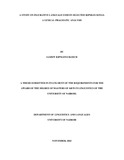| dc.description.abstract | This study presented the results of linguistic study on the language used in selected Kipsigis
songs. The study uses a lexical pragmatics framework. What the study aimed at was to
examine lexical items that form the nucleus of meaning and analyzes its variation as
perceived by the audience. The findings affirmed that lexical items use in the selected songs
are transfer of meaning which acquire activation through encyclopaedic entry that work as
weak implicatures in the Relevance Theory.
Chapter one provides the introduction, the background to the study, statement of the problem,
objectives, hypotheses, scope and limitations, theoretical framework, literature review,
methodology and conclusion. Chapter two focuses on the linguistic nature and characteristics
of the songs under study. The chapter discussed the choice of vocabulary and linguistics
strategies that artists employ in their songs. The chapter discussed various figurative elements
which include metaphors, symbolisms, proverbs and sayings and personification. It also
discussed word formation processes like borrowing, derivation and clipping.
Chapter three concentrates on the analysis of several lexical items used in the selected
Kipsigis songs. Meanings of several lexical items used figuratively in the selected songs were
examined. Lexical pragmatic theory was used to explain the lexical items that may pose
misinterpretation and misunderstanding in the selected songs. Some of the aspects treated in
the analyses of figurative language include metaphors, symbolism, personification and
proverbs which proved to be prevalent in the selected songs. The Chapter demonstrated that
the meaning of lexical items used in the selected Kipsigis songs go beyond the usual
linguistics properties of utterances, hence there was a need to use contextual information to
arrive at the expected interpretations. Finally chapter four is a summary of the findings and
recommendations were presented. It provides a suggestion for a further research. | en |

